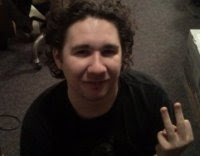- Jeff Noon
This is the man who wrote a "trequel" (his own name for the third book in a series) to Alice's Adventures in Wonderland. I'll just let that sink in for a moment.
Okay, back to live action.
The story begins with Alice trying to finish her jigsaw of the London Zoo as her Great Aunt Ermintrude calls for her so the two of them can start a lesson on the usage of the ellipse. Due to Alice's naturally odd nature and impulsiveness, she gives in to an urge to let her aunt and uncle's parrot, Whippoorwill out of his cage. Whippoorwill then flies around the room, despite Alice's best efforts to get him back in, and into the grandfather clock, where he vanishes out of sight. Alice, desperate to recapture him before her Great Aunt can find out, follows him through the workings of the clock, emerging in a "computermite mound" in far-future Manchester. From there, she embarks on a rather odd journey to get home by two o'clock in her own time, find all the missing pieces of her London Zoo jigsaw puzzle, and capture the troublesome parrot. But future Manchester is a terrible place, filled with creatures like the "Civil Serpents", snakes who believe in absolute order and bureaucracy, and a race of people affected by a disease known as "Newmonia" that scrambles their genetic code and makes them anthropomorphic. Plaguing the city is someone known as the "Jigsaw Murderer", who is killing people by reorganizing their parts in the wrong ways. Before her journey is over, Alice will have been swallowed by a snake, solved the murder, and met a robot exactly like her, as well as finding out the true use for an ellipsis.
I can't really apply my usual method to this one. While I could talk about the characters, they're little more than concepts used-- the two main characters are Alice and a robot statue of Alice named Celia. The rest is a landscape of puns, both visual and textual, and the feel of the book is right along with the original source material. Noon definitely knows what he's doing, and his faithfulness towards Lewis Carroll and his work-- both historically and in a literary sense. Overall, there is a sense of fun that permeates the novel. Noon had fun writing this and playing with the various aspects of modern society: Bureaucracy, entertainment, and even modern art and music are poked fun of in a manner of ways, from director "Quentin Tarantula" to the overly-saccharine nature of the kiddie "lantern shows".
What really makes the book what it is, though, is the sense that you're reading another Alice book. The illustrations look like they've been cribbed from John Tenniel, the illustrator for the actual Alice In Wonderland books, and even the writing, when Noon decides to leave the fourth wall intact, follows the stilted but very pleasant prose. And what really pushes things over the edge is when it starts to slip. You see, Automated Alice plays fast and loose with even its own reality. At times, despite the pleasant prose, things happen oddly. For example, why is it Alice knows who Charles Dodgson, the mathematician and creator of her books, is? And furthermore, is she dead, trapped in unreality, or some odd combination of those things? When Noon really starts to explore all the aspects of Alice and Alice's reality, he really proves he's definitely done the research into the character. After all, this is a book about Alice, in all her various forms (yes, even automated), and as much about how the character is and came to be as it is about what goes on in the story.
The only problem is that Noon has too much fun. As in way too much. Be it his ponderings on his place as the author (he shows up as a character), his "or is it?" ending, the metafictional way he goes about things, or the oh aren't I so clever jabs at quantum physics and the like. Eventually, it just gets kind of annoying, though never terribly so. The action also seems beside the point given the metafictional nature of the work, though given last week's entry, the fact that it occurs organically from the story, rather than occurring in spite of the story is a massive plus. Personally, I think the metafiction doesn't distract too much, but the whole business is a little too silly, a little too tongue-in-cheek. It's like an essay couched in the terms of a narrative story or something. Furthermore, the connections to other books are a little too obvious and silly at some points, referencing things from other books he wrote. They kind of get in the way.
But without these touches, or even if you manage to look at the work as a fiction story instead of an exploration of reality, the book is fantastic. It's a fun little story that manages to stay true to its own roots, and at the same time bring Jeff Noon's own psychotic touches and weirdness overload to the forefront. It's well worth a read, and I recommend it wholeheartedly, even if I'm not quite able to discuss the plot elements without getting into the whole "fourth-wall" nature of the book. It's worth reading, especially if you enjoy surrealism and the Alice books by Lewis Carroll. Definitely give this one a look.
Tomorrow: The return of the Monster Who Hunts Monsters, James Stark, in Richard Kadrey's Kill The Dead.







No comments:
Post a Comment